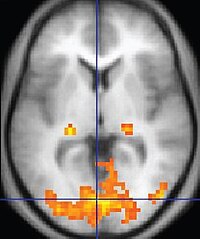
Photo from wikipedia
Previous studies have indicated that changes in oxygenated hemoglobin concentration (O2Hb) in the prefrontal cortex (PFC) are associated with changes in cognitive function. Therefore, the present study aimed to explore… Click to show full abstract
Previous studies have indicated that changes in oxygenated hemoglobin concentration (O2Hb) in the prefrontal cortex (PFC) are associated with changes in cognitive function. Therefore, the present study aimed to explore the effect of differences in O2Hb levels in the left and right PFC (L-PFC and R-PFC, respectively) on cognitive function after exercise. This study included 12 healthy male college students. The exercise regimen consisted of 4 min of warm-up and rest each, followed by 20 min of moderate-intensity exercise and 20 min of post-exercise rest. Participants underwent the 2-back cognitive test thrice (pre-exercise, post-exercise, and after the 20 min post-exercise rest period), and their reaction times were recorded. O2Hb levels in the PFC were monitored using functional near-infrared spectroscopy. We analyzed the correlations between changes in post-exercise reaction times and differences in peak O2Hb levels (L-PFC minus R-PFC), area under the curve for O2Hb changes, and increases in the O2Hb slope during exercise. Peak O2Hb, area under the curve (AUC) for O2Hb change, and increase in the slope of O2Hb were significantly correlated with changes in reaction time. These findings provide insight into the mechanism by which O2Hb differences between the L-PFC and R-PFC affect cognitive function.
Journal Title: Applied Sciences
Year Published: 2021
Link to full text (if available)
Share on Social Media: Sign Up to like & get
recommendations!